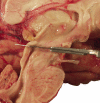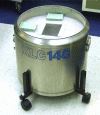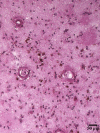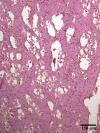Twenty-first century brain banking. Processing brains for research: the Columbia University methods
- PMID: 17985145
- PMCID: PMC2292479
- DOI: 10.1007/s00401-007-0311-9
Twenty-first century brain banking. Processing brains for research: the Columbia University methods
Abstract
Carefully categorized postmortem human brains are crucial for research. The lack of generally accepted methods for processing human postmortem brains for research persists. Thus, brain banking is essential; however, it cannot be achieved at the cost of the teaching mission of the academic institution by routing brains away from residency programs, particularly when the autopsy rate is steadily decreasing. A consensus must be reached whereby a brain can be utilizable for diagnosis, research, and teaching. The best diagnostic categorization possible must be secured and the yield of samples for basic investigation maximized. This report focuses on integrated, novel methods currently applied at the New York Brain Bank, Columbia University, New York, which are designed to reach accurate neuropathological diagnosis, optimize the yield of samples, and process fresh-frozen samples suitable for a wide range of modern investigations. The brains donated for research are processed as soon as possible after death. The prosector must have a good command of the neuroanatomy, neuropathology, and the protocol. One half of each brain is immersed in formalin for performing the thorough neuropathologic evaluation, which is combined with the teaching task. The contralateral half is extensively dissected at the fresh state. The anatomical origin of each sample is recorded using the map of Brodmann for the cortical samples. The samples are frozen at -160 degrees C, barcode labeled, and ready for immediate disbursement once categorized diagnostically. A rigorous organization of freezer space, coupled to an electronic tracking system with its attached software, fosters efficient access for retrieval within minutes of any specific frozen samples in storage. This report describes how this achievement is feasible with emphasis on the actual processing of brains donated for research.
Figures






















Comment in
-
Twenty-first century brain banking: at the crossroads.Acta Neuropathol. 2008 May;115(5):493-6. doi: 10.1007/s00401-008-0363-5. Acta Neuropathol. 2008. PMID: 18347804
Similar articles
-
Twenty-first century brain banking: practical prerequisites and lessons from the past: the experience of New York Brain Bank, Taub Institute, Columbia University.Cell Tissue Bank. 2008 Sep;9(3):247-58. doi: 10.1007/s10561-008-9079-y. Epub 2008 Jun 26. Cell Tissue Bank. 2008. PMID: 18581261 Free PMC article.
-
[The current state of the New York Brain Bank and a proposal for the establishment of the brain bank network in Japan].Brain Nerve. 2010 Oct;62(10):1035-42. Brain Nerve. 2010. PMID: 20940502 Japanese.
-
Electronic tracking of human brain samples for research.Cell Tissue Bank. 2008 Sep;9(3):217-27. doi: 10.1007/s10561-008-9078-z. Epub 2008 Jul 9. Cell Tissue Bank. 2008. PMID: 18612850 Free PMC article.
-
The New York Brain Bank of Columbia University: practical highlights of 35 years of experience.Handb Clin Neurol. 2018;150:105-118. doi: 10.1016/B978-0-444-63639-3.00008-6. Handb Clin Neurol. 2018. PMID: 29496134 Review.
-
Psychiatric brain banking: three perspectives on current trends and future directions.Biol Psychiatry. 2011 Jan 15;69(2):104-12. doi: 10.1016/j.biopsych.2010.05.025. Epub 2010 Jul 31. Biol Psychiatry. 2011. PMID: 20673875 Free PMC article. Review.
Cited by
-
Regulation of dopamine D₃ receptor in the striatal regions and substantia nigra in diffuse Lewy body disease.Neuroscience. 2013 Sep 17;248:112-26. doi: 10.1016/j.neuroscience.2013.05.048. Epub 2013 Jun 1. Neuroscience. 2013. PMID: 23732230 Free PMC article.
-
Neuropathologic assessment of participants in two multi-center longitudinal observational studies: the Alzheimer Disease Neuroimaging Initiative (ADNI) and the Dominantly Inherited Alzheimer Network (DIAN).Neuropathology. 2015 Aug;35(4):390-400. doi: 10.1111/neup.12205. Epub 2015 May 12. Neuropathology. 2015. PMID: 25964057 Free PMC article.
-
Climbing fiber-Purkinje cell synaptic pathology in tremor and cerebellar degenerative diseases.Acta Neuropathol. 2017 Jan;133(1):121-138. doi: 10.1007/s00401-016-1626-1. Epub 2016 Oct 4. Acta Neuropathol. 2017. PMID: 27704282 Free PMC article.
-
Validity of the 2014 traumatic encephalopathy syndrome criteria for CTE pathology.Alzheimers Dement. 2021 Oct;17(10):1709-1724. doi: 10.1002/alz.12338. Epub 2021 Apr 7. Alzheimers Dement. 2021. PMID: 33826224 Free PMC article.
-
A neurodegenerative disease landscape of rare mutations in Colombia due to founder effects.Genome Med. 2022 Mar 8;14(1):27. doi: 10.1186/s13073-022-01035-9. Genome Med. 2022. PMID: 35260199 Free PMC article.
References
-
- {'text': '', 'ref_index': 1, 'ids': [{'type': 'DOI', 'value': '10.1111/j.1471-4159.1979.tb04607.x', 'is_inner': False, 'url': 'https://doi.org/10.1111/j.1471-4159.1979.tb04607.x'}, {'type': 'PubMed', 'value': '34670', 'is_inner': True, 'url': 'https://pubmed.ncbi.nlm.nih.gov/34670/'}]}
- Albrecht J, Yanagihara T (1979) Effect of anoxia and ischemia on ribonuclease activity in brain. J Neurochem 32:1131–1133 - PubMed
-
- {'text': '', 'ref_index': 1, 'ids': [{'type': 'PMC', 'value': 'PMC6578676', 'is_inner': False, 'url': 'https://pmc.ncbi.nlm.nih.gov/articles/PMC6578676/'}, {'type': 'PubMed', 'value': '8774439', 'is_inner': True, 'url': 'https://pubmed.ncbi.nlm.nih.gov/8774439/'}]}
- Anderson AJ, Su JH, Cotman CW (1996) DNA damage and apoptosis in Alzheimer’s disease: colocalization with c-Jun immunoreactivity, relationship to brain area, and effect of postmortem delay. J Neurosci 16:1710–1719 - PMC - PubMed
-
- {'text': '', 'ref_index': 1, 'ids': [{'type': 'PMC', 'value': 'PMC1083246', 'is_inner': False, 'url': 'https://pmc.ncbi.nlm.nih.gov/articles/PMC1083246/'}, {'type': 'PubMed', 'value': '125784', 'is_inner': True, 'url': 'https://pubmed.ncbi.nlm.nih.gov/125784/'}]}
- Aquilonius SM, Eckernäs SA, Sundwall A (1975) Regional distribution of choline actyltransferase in the human brain: changes in Huntington’s chorea. J Neurol Neurosurg Psychiatry 38:669–677 - PMC - PubMed
-
- {'text': '', 'ref_index': 1, 'ids': [{'type': 'DOI', 'value': '10.1016/S0891-0618(01)00099-0', 'is_inner': False, 'url': 'https://doi.org/10.1016/s0891-0618(01)00099-0'}, {'type': 'PubMed', 'value': '11470556', 'is_inner': True, 'url': 'https://pubmed.ncbi.nlm.nih.gov/11470556/'}]}
- Bahn S, Augood SJ, Ryan M, Standaert DG, Starkey M, Emson PC (2001) Gene expression profiling in the post-mortem human brain––no cause for dismay. J Chem Neuroanat 22:79–94 - PubMed
-
- {'text': '', 'ref_index': 1, 'ids': [{'type': 'DOI', 'value': '10.1111/j.1471-4159.1993.tb03532.x', 'is_inner': False, 'url': 'https://doi.org/10.1111/j.1471-4159.1993.tb03532.x'}, {'type': 'PubMed', 'value': '7685811', 'is_inner': True, 'url': 'https://pubmed.ncbi.nlm.nih.gov/7685811/'}]}
- Barton AJ, Pearson RC, Najlerahim A, Harrison PJ (1993) Pre- and postmortem influences on brain RNA. J Neurochem 61:1–11 - PubMed
Publication types
MeSH terms
Grants and funding
LinkOut - more resources
Full Text Sources

